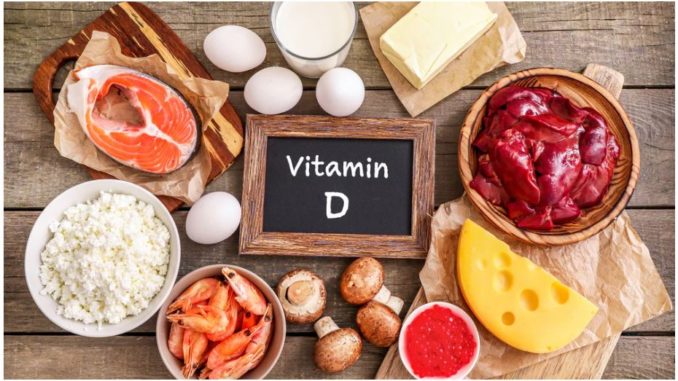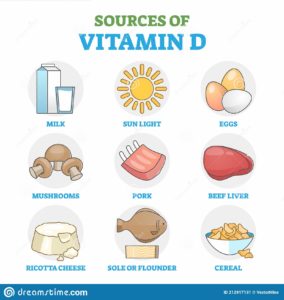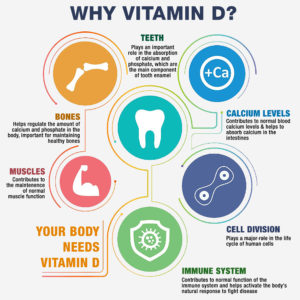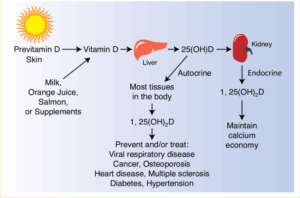
Table of Contents
What is Vitamin D?
- Vitamin D is a nutrient that is required in our body in order to develop and maintain strong bones.
- Vitamin D is a type of vitamin that helps the body to absorb and retain calcium and phosphorus.
- Vitamin D is a fat-soluble vitamin that is added to certain foods, found naturally in a few, and available as a dietary supplement.
- Vitamin D is both a nutrient that we eat and a hormone that our body produces
- This is due to the fact that vitamin D is required for our body to properly absorb calcium, which is the main component of bone.
- The human body produces vitamin D endogenously as a response to sun exposure where ultraviolet (UV) rays from sunlight strike the skin and trigger its synthesis.
- A person can boost their intake by eating specific foods or taking supplements.
Sources of Vitamin D
- Few foods naturally contain vitamin D, while some are fortified with it.
- Supplements is another good sources of Vitamin D. There are two types of vitamin D supplements: vitamin D2 (also known as ergocalciferol or pre-vitamin D) and vitamin D3 (also known as cholecalciferol).
- The term “the sunshine vitamin” refers to both of these naturally occurring forms, which are generated when exposed to ultraviolet-B (UVB) rays from the sun.
- However, D2 is produced by plants and fungi, whereas D3 is produced by mammals, including humans.
- The flesh of fatty fish and fish liver oils are also the finest sources of vitamin D.
- Cheese, cow liver, and egg yolks all contain smaller quantities.
- Some mushrooms contain vitamin D2, and some mushrooms that are marketed commercially have higher levels of vitamin D2 because they have been purposefully exposed to a lot of UV radiation.
- Vitamin D is added to a variety of foods and supplements, such as in cereals and dairy products.

Food sources of Vitamin D include:
- Cod liver oil
- Salmon
- Swordfish
- Tuna fish
- Fortified orange juice
- Vitamin D-fortified dairy and plant milks
- Sardines
- Egg yolk
- Fortified cereals
Functions
- Helps to retain calcium and phosphorus
- Reduces cancer cell growth
- Helps to control infections and reduces inflammation
- Maintains healthy bone and teeth
- Improves immunity
- Reduces the risk of autoimmune diseases
- Helps to strengthen muscles
- Provides strength and support to the skeletal frame of the body
- Reduces obesity and maintains proper weight

Recommended Dietary Allowance (RDA)
The amount of vitamin D you need each day depends on age. The recommended dietary allowance in international units (IU), are:
- Birth to 12 months: 400 IU
- Children (1-13 years): 600 IU
- Teens (14-18 years): 600 IU
- Adults (19-70 years): 600 IU
- Adults (71 years and older): 800 IU
- Pregnant and breastfeeding women: 600 IU
- Those who are most at risk for vitamin D deficiency can require more
Health Benefits
- Calcium, the building block of bones, is absorbed by the body as a result of the presence of Vitamin D, which is particularly important in the natural growth and remodeling of bones.
- It lowers the danger of fracture, strengthens the bones, keeps the body’s balance, and gives the body a strong, ideal skeletal framework.
- A by-product of vitamin D aids in the relaxation and contraction of muscles.
- It strengthens gums, lowers the incidence of oral infections, and prevents tooth damage and loss.
- Being a fat-soluble vitamin, it is essential for controlling renal functioning and safeguarding the kidney against infections.
- It is crucial for cellular development, maintenance, and metabolism. The healing and restoration of wounds can be greatly aided by a decent amount of sunlight exposure.
- Additionally, it is essential for preventing obesity and maintaining a healthy weight.
- The abundance of vitamin D in the body restores the function of leptin, which makes us feel full and lessens the tendency to constantly nibble, helping to lose weight.
Signs and Symptoms of Vitamin D Deficiency
- Children who have mild vitamin deficiencies may only experience weakness, discomfort, or pain in their muscles.
- On the other hand, children who severely lack Vitamin D will develop Rickets.
- Symptoms of rickets include:
- Bowed or bent bones that cause improper development patterns
- Muscle weakness
- Bone pain
- Deformities in joints
- Most adults who are vitamin D deficient don’t exhibit any symptoms.
- However, a continuous deficiency can lead to hypocalcemia, a disease in which there is insufficient calcium, and hyperparathyroidism, a condition in which the parathyroid glands generate an imbalanced hormone that raises the blood calcium levels.
- These conditions can lead to secondary symptoms of Vitamin D deficiency. It may may include:
- Tiredness, aches, and pains
- Osteoporosis
- Stress fractures, particularly in the legs, pelvis, and hips
- Extreme numbness or pain in the muscles or bones.
- Mood changes, like depression
Consequences of Vitamin D Deficiency
- Children with vitamin D deficiency have growth retardation as well as the typical rickets signs and symptoms.
- Adults with Vit. D deficiency will experience osteopenia, osteoporosis, and an increase in fracture risk.
- Vitamin D deficiency has long been linked to muscle weakness.
- Skeletal muscle has a vitamin D receptor, and deficiencies have been linked to proximal muscle weakening, an increase in body sway, and a higher risk of falling.
- Adults with Vit. D deficiency may also have abnormal skeletal mineralization.
- The periosteal coating receives minimal structural support from the unmineralized osteoid.
- As a result, individuals with osteomalacia may express isolated or generalized bone soreness in addition to joint and muscle pain.
Complications of Vitamin D Deficiency
If Vit. D deficiency continues for a long period, it may result in following consequences:
- Cardiovascular condition
- Autoimmune problems
- Neurological diseases
- Infections
- Pregnancy complications
- Certain types of cancer including breast, prostate and colon
Groups/Persons At High Risk of Vitamin D Deficiency
- Breastfed infants, because human milk is a poor source of vitamin D
- Older adults, because skin doesn’t make vitamin D when exposed to sunlight as efficiently as when young
- People with dark skin, can synthesize less vitamin from sunlight.
- Those who cannot adequately manage fat due to conditions like Crohn’s disease or celiac disease, as Vit. D needs fat to be absorbed.
- Obese people, as some vitamin D is bound by body fat in these individuals and cannot enter the bloodstream.
- Individuals who had gastric bypass surgery
- Those who have osteoporosis
- Those who suffer from liver or renal problems.
- Those who have hyperparathyroidism
- Patients with sarcoidosis, tuberculosis, histoplasmosis, and other granulomatous disorders
- People who have certain types of lymphomas
- People who use medications that interfere with vitamin D metabolism, such as cholestyramine (a cholesterol medication), anti-seizure medications, glucocorticoids, antifungal medications, and HIV/AIDS medications.
References and For More Information
https://www.hsph.harvard.edu/nutritionsource/vitamin-d/
https://ods.od.nih.gov/factsheets/VitaminD-HealthProfessional/
https://www.nhs.uk/conditions/vitamins-and-minerals/vitamin-d/
https://www.webmd.com/vitamins/ai/ingredientmono-929/vitamin-d
https://www.mayoclinic.org/drugs-supplements-vitamin-d/art-20363792
https://my.clevelandclinic.org/health/diseases/15050-vitamin-d-vitamin-d-deficiency
https://examine.com/supplements/vitamin-d/
https://www.hopkinsmedicine.org/health/wellness-and-prevention/vitamin-d-and-calcium
https://academic.oup.com/ajcn/article/87/4/1080S/4633477
https://medlineplus.gov/vitaminddeficiency.html
https://www.medicalnewstoday.com/articles/161618#symptoms
